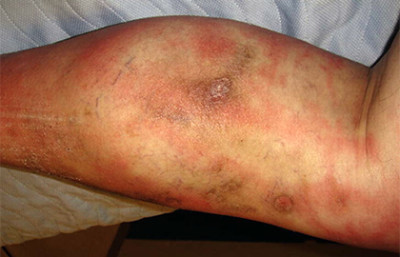Cellulitis: Overview
What is cellulitis?
Cellulitis is a common and potentially serious infection caused by bacteria. The bacteria infect the deep layers of skin and tissue beneath the skin.
The first sign of cellulitis is usually red and swollen skin. When you touch the infected area, it often feels warm and tender.
This infection can show up anywhere on the skin. Adults often get it in a lower leg. In children, cellulitis tends to appear on the face or neck.
Cellulitis on the lower leg
Cellulitis causes redness, which may cover the entire area of be blotchy, as shown here.

While cellulitis often develops in a leg, redness and swelling in both legs usually means you have another condition. You could have stasis dermatitis or contact dermatitis.
If you think you have cellulitis, you should get immediate medical care. Caught early and treated, cellulitis usually clears completely without causing any long-term problems.
Without treatment, the infection can spread quickly. The bacteria may travel to lymph nodes and into the bloodstream. This can lead to a blood infection or permanently damage lymph vessels, which are part of your immune system. Other complications can also develop.
When treated before complications occur, most people recover fully. Caught early, your doctor can treat it with oral (take by mouth) antibiotics and good wound care.
After starting treatment for cellulitis, you should notice improvement in 24 to 48 hours. If you don’t, call your doctor’s office. Severe cellulitis may require you to be treated in a hospital.
Image
Image used with permission of Journal of the American Academy of Dermatology: J Am Acad Dermatol 2012; 67:163.e1-12
References
Al-Niaimi F, Neil Cox N. “Cellulitis and lymphedema: A vicious cycle.” J of Lymphoedema.” 2009;4(2):38-42.
Hirschmann, JV and Raugi GJ. “Lower limb cellulitis and its mimics: Part I. Lower limb cellulitis.” J Am Acad Dermatol 2012;67:163.e1-12.
Raff AB, Kroshinsky D. “Cellulitis: A review.” JAMA. 2016;316(3):325-337.
 Atopic dermatitis: More FDA-approved treatments
Atopic dermatitis: More FDA-approved treatments
 Biosimilars: 14 FAQs
Biosimilars: 14 FAQs
 How to trim your nails
How to trim your nails
 Relieve uncontrollably itchy skin
Relieve uncontrollably itchy skin
 Fade dark spots
Fade dark spots
 Untreatable razor bumps or acne?
Untreatable razor bumps or acne?
 Tattoo removal
Tattoo removal
 Scar treatment
Scar treatment
 Free materials to help raise skin cancer awareness
Free materials to help raise skin cancer awareness
 Dermatologist-approved lesson plans, activities you can use
Dermatologist-approved lesson plans, activities you can use
 Find a Dermatologist
Find a Dermatologist
 What is a dermatologist?
What is a dermatologist?